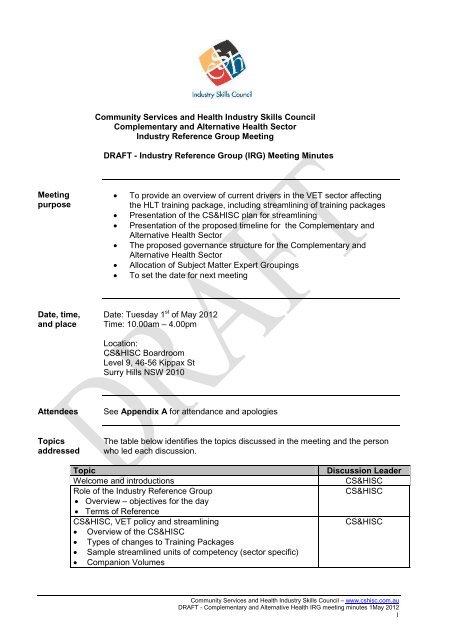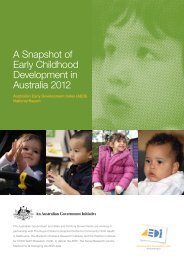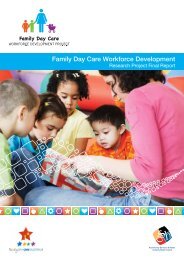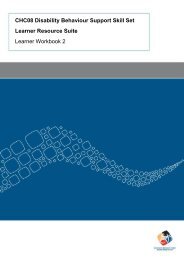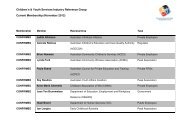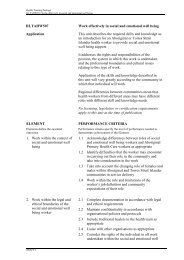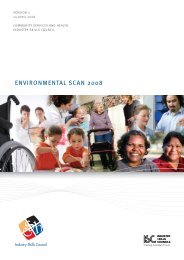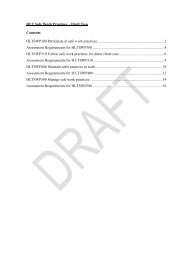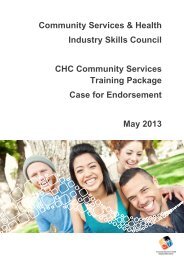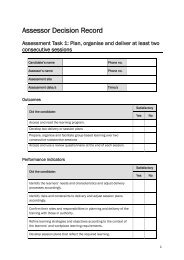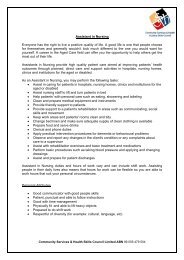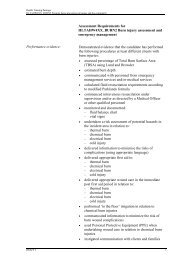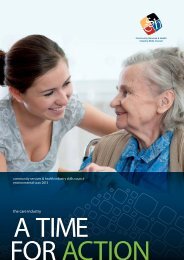IRG meeting minutes - Community Services & Health Industry Skills ...
IRG meeting minutes - Community Services & Health Industry Skills ...
IRG meeting minutes - Community Services & Health Industry Skills ...
Create successful ePaper yourself
Turn your PDF publications into a flip-book with our unique Google optimized e-Paper software.
Meeting<br />
purpose<br />
Date, time,<br />
and place<br />
<strong>Community</strong> <strong>Services</strong> and <strong>Health</strong> <strong>Industry</strong> <strong>Skills</strong> Council<br />
Complementary and Alternative <strong>Health</strong> Sector<br />
<strong>Industry</strong> Reference Group Meeting<br />
DRAFT - <strong>Industry</strong> Reference Group (<strong>IRG</strong>) Meeting Minutes<br />
� To provide an overview of current drivers in the VET sector affecting<br />
the HLT training package, including streamlining of training packages<br />
� Presentation of the CS&HISC plan for streamlining<br />
� Presentation of the proposed timeline for the Complementary and<br />
Alternative <strong>Health</strong> Sector<br />
� The proposed governance structure for the Complementary and<br />
Alternative <strong>Health</strong> Sector<br />
� Allocation of Subject Matter Expert Groupings<br />
� To set the date for next <strong>meeting</strong><br />
Date: Tuesday 1 st of May 2012<br />
Time: 10.00am – 4.00pm<br />
Location:<br />
CS&HISC Boardroom<br />
Level 9, 46-56 Kippax St<br />
Surry Hills NSW 2010<br />
Attendees See Appendix A for attendance and apologies<br />
Topics<br />
addressed<br />
The table below identifies the topics discussed in the <strong>meeting</strong> and the person<br />
who led each discussion.<br />
Topic Discussion Leader<br />
Welcome and introductions CS&HISC<br />
Role of the <strong>Industry</strong> Reference Group<br />
CS&HISC<br />
� Overview – objectives for the day<br />
� Terms of Reference<br />
CS&HISC, VET policy and streamlining<br />
CS&HISC<br />
� Overview of the CS&HISC<br />
� Types of changes to Training Packages<br />
� Sample streamlined units of competency (sector specific)<br />
� Companion Volumes<br />
<strong>Community</strong> <strong>Services</strong> and <strong>Health</strong> <strong>Industry</strong> <strong>Skills</strong> Council – www.cshisc.com.au<br />
DRAFT - Complementary and Alternative <strong>Health</strong> <strong>IRG</strong> <strong>meeting</strong> <strong>minutes</strong> 1May 2012<br />
1
Welcome and<br />
introductions<br />
Role of the<br />
<strong>Industry</strong><br />
Reference<br />
Group<br />
CS&HISC, VET<br />
policy and<br />
streamlining<br />
CS&HISC work plan<br />
� Timelines<br />
� Deliverables<br />
Governance structure<br />
� Subject Matter Expert Groups (SMEGs)<br />
� Priority areas and questions for discussion<br />
Workforce Development<br />
� Training Quality<br />
Other business<br />
� Next <strong>IRG</strong> <strong>meeting</strong><br />
CS&HISC and <strong>IRG</strong><br />
members<br />
CS&HISC and <strong>IRG</strong><br />
members<br />
CS&HISC<br />
CS&HISC<br />
The CS&HISC project lead welcomed the <strong>IRG</strong> members, conducted<br />
housekeeping, and invited members to introduce themselves and the<br />
organisation they are representing.<br />
It was discussed with the <strong>IRG</strong> members that the project lead would be<br />
the chair for the day; a nominated member from the group was asked<br />
to chair the next <strong>meeting</strong>. Nominations to be emailed to the project<br />
lead.<br />
The project lead introduced the agenda and the <strong>meeting</strong> objectives of<br />
the day.<br />
Action item 1: <strong>IRG</strong> members to nominate a chair for the next <strong>meeting</strong><br />
The project lead referred to the terms of reference and invited <strong>IRG</strong><br />
members to comment. The <strong>IRG</strong> accepted the terms of reference and<br />
was moved by David Stelfox and seconded by Claudia Joy Wingo.<br />
Terms of reference and other <strong>meeting</strong> documentation will be available<br />
on the Complementary and Alternative <strong>Health</strong> Sector project page on<br />
the CS&HISC website.<br />
The CS&HISC project lead provided a profile of the CS&HISC and its<br />
governance structure; including the structure of the <strong>IRG</strong> and the<br />
Training Package Advisory Committee (TPAC). It was explained to the<br />
group that David Stelfox was the Complementary and Alternative<br />
<strong>Health</strong> committee representative on the TPAC and if they would like<br />
anything to be discussed or raised at the TPAC level to contact David.<br />
Key industry intelligence and a general overview of the 2012<br />
Environmental Scan was provided, as well as public enrolment data<br />
for the health sector for 2010. (Please see the Power point<br />
presentation from this <strong>meeting</strong>)<br />
<strong>Community</strong> <strong>Services</strong> and <strong>Health</strong> <strong>Industry</strong> <strong>Skills</strong> Council – www.cshisc.com.au<br />
DRAFT - Complementary and Alternative <strong>Health</strong> <strong>IRG</strong> <strong>meeting</strong> <strong>minutes</strong> 1May 2012<br />
2
Overview of NSSC streamlining policy<br />
The CS&HISC Training Packages Manager provided an overview of<br />
Training Packages and the National <strong>Skills</strong> Standards Council’s<br />
(NSSC) reform of Training Packages, in particular the implementation<br />
of the ‘streamlined’ design model for Training Packages. Below is a<br />
summary of points presented and discussed.<br />
Qualifications<br />
� Qualifications reflect the job roles<br />
� “Nested” qualifications not allowed in new model – this<br />
includes move away from entry requirements where possible<br />
� Focus on flexibility by keeping core units to a minimum and<br />
wide range of electives – however acknowledge that a<br />
qualification needs to describe the job role so if there are tasks<br />
that must be completed by all workers, these should be core<br />
� Move towards skill sets to broaden and specialise<br />
� Credit arrangements – proposed in new design model although<br />
details have not been finalised by NSSC. <strong>IRG</strong> will be informed<br />
when developments are made on this front.<br />
� The CS&HISC highlighted that streamlining promotes a move<br />
away from entry requirements for qualifications. Should a<br />
qualification require the skills and knowledge of a lower level<br />
qualification then this need to be explicit in the qualification<br />
� Qualifications should be seen as stand along<br />
Units of Competency<br />
� Reflect performance standards for specific job tasks<br />
� Will be divided into two sections (‘two documents’):<br />
o performance standards for the workplace<br />
o assessment requirements<br />
� Range Statement to be removed and replaced with a Range of<br />
Conditions. The existing contents are to be reviewed and<br />
incorporated into assessment requirements or companion<br />
volume/implementation guide.<br />
� Foundation skills (ACSF + employability skills) section which<br />
are assessable<br />
� Move away from pre-requisite units as these denote “hidden<br />
effort” – these must only be kept if a job task requires formally<br />
assessed competence in another task before being able to<br />
undertake it.<br />
� There is scope for the Assessment Requirements to be<br />
prescriptive and specific depending on industry needs e.g.<br />
How often does someone have to perform a skill to<br />
demonstrate competency? Where does it have to be done?<br />
Can it be done in a simulated environment?<br />
� Move away from unit “levels” as units describe what a person<br />
does in their job, not the level it is performed (e.g. low “level”<br />
admin units in a Diploma qualification)<br />
� Assessment requirements could be a basis of a performance<br />
review – more flexible for other options, and probably for<br />
recognition<br />
<strong>Community</strong> <strong>Services</strong> and <strong>Health</strong> <strong>Industry</strong> <strong>Skills</strong> Council – www.cshisc.com.au<br />
DRAFT - Complementary and Alternative <strong>Health</strong> <strong>IRG</strong> <strong>meeting</strong> <strong>minutes</strong> 1May 2012<br />
3
Companion Volumes<br />
� Quality assured “Implementation Guides” for users (industry,<br />
RTOs, learners)<br />
� CS&HISC is not currently funded to develop companion<br />
volumes, however will be developed wherever feasible<br />
through the scope of this project<br />
� The <strong>IRG</strong> discussed possibilities for including guide to<br />
Foundation skills and ACSF for trainers who are not familiar<br />
with these terms<br />
Quality Principles<br />
� Quality principles will be used this to guide decision making<br />
process during development and drafting of new components<br />
� Quality principles form part of the case for endorsement that<br />
must be submitted to the NSSC for new training package<br />
material, these criteria must be met and should be considered<br />
early<br />
Sample streamlining units of competency (sector specific)<br />
The CS&HISC project lead presented a sample streamlined unit of<br />
competency from the aromatherapy qualification - (HLTARO401B)<br />
The <strong>IRG</strong> discussed nominal hours/funding models and the difference<br />
between this and assessment conditions. It was highlighted that the<br />
wording within the assessment conditions had to be concise and<br />
agreed by industry so that industry/association criteria are met; clear<br />
and concise language to assess the student as competent.<br />
The CS&HISC identified that at a unit level there would not be any<br />
identification of other units that could be assessed holistically and in<br />
conjunction with that unit, this was not the intent of streamlining.<br />
The <strong>IRG</strong> discussed:<br />
� the groups role in responsiveness by moderating feedback<br />
provided by the industry<br />
� assessment context and simulated environment verses<br />
workplace assessment.<br />
� an industry definition of supervised practice in relation to<br />
assessment would be good to have.<br />
� the shift in terminology of the title ‘Complementary and<br />
Alternative <strong>Health</strong>’, a movement to new terminology to only<br />
using ‘complementary health’ or would it be possible to use<br />
‘complementary medicine’.<br />
Action item 2 – for CS&HISC, the <strong>IRG</strong> asked would it be possible to<br />
get an industry definition of ‘supervised practise’ in relation to<br />
assessment<br />
Action item 3 – CS&HISC to add terminology discussion point as a<br />
standing agenda item for future <strong>IRG</strong>’s and SMEG’s<br />
<strong>Community</strong> <strong>Services</strong> and <strong>Health</strong> <strong>Industry</strong> <strong>Skills</strong> Council – www.cshisc.com.au<br />
DRAFT - Complementary and Alternative <strong>Health</strong> <strong>IRG</strong> <strong>meeting</strong> <strong>minutes</strong> 1May 2012<br />
4
CS&HISC work<br />
plan/governance<br />
structure<br />
Priority<br />
areas/feedback<br />
from CIP<br />
Subject Matter Expert Groups (SMEGs)<br />
The CS&HISC project lead provided an overview of the Continuous<br />
Improvement Process (CIP) and led the discussion on the sector<br />
priorities influencing the project. A framework for the Subject Matter<br />
Expert Groups (SMEGs) was presented and <strong>IRG</strong> members agreed<br />
that the proposed SMEGs were a good reflection of groupings.<br />
The CS&HISC project lead explained to the <strong>IRG</strong> that they could<br />
nominate relevant people for the Subject Matter Expert Groups with<br />
each group having approximately 3-6 members per SMEG. <strong>IRG</strong><br />
members were asked to provide a rational for their SMEG<br />
nominations. <strong>IRG</strong> members could nominate themselves to sit on these<br />
SMEGs.<br />
The <strong>IRG</strong> agreed the following waves/SMEG groupings for phase 2<br />
and 3:<br />
First wave:<br />
� remedial massage/ massage therapy practice<br />
� aromatherapy/ aromatic medicine<br />
� kinesiology<br />
Second wave:<br />
� reflexology<br />
� shiatsu and oriental therapies<br />
Third Wave:<br />
� ayurveda<br />
� chinese medicine remedial massage (An Mo Tui Na)<br />
Fourth Wave<br />
� homeopathy<br />
� western herbal medicine<br />
� nutritional medicine/ naturopathy<br />
Action item 4: <strong>IRG</strong> members to send SMEG nominations to the<br />
project lead<br />
The CS&HISC Project Lead gave an overview of feedback received to<br />
date through the CS&HISC CIP that was not actioned in the latest<br />
version of the training package.<br />
The feedback was presented to the group for validation. Feedback<br />
that required smaller changes was validated that it was still current<br />
and could be addressed alongside streamlining.<br />
� Feedback item 1 – Request to develop Certificate IV in<br />
Reflexology (as an entry level to the profession) – <strong>IRG</strong> agreed<br />
that this feedback was still valid.<br />
� Feedback item 2 and 3 – Investigate development of<br />
Advanced Diploma of Kinesiology and review Certificate IV and<br />
<strong>Community</strong> <strong>Services</strong> and <strong>Health</strong> <strong>Industry</strong> <strong>Skills</strong> Council – www.cshisc.com.au<br />
DRAFT - Complementary and Alternative <strong>Health</strong> <strong>IRG</strong> <strong>meeting</strong> <strong>minutes</strong> 1May 2012<br />
5
Diploma in Kinesiology – particularly range statements –<br />
Agreed by the <strong>IRG</strong> member representing the area for<br />
Kinesiology.<br />
� Feedback item 4 - Certificate IV in Aromatherapy – review<br />
essential skills and knowledge with regard to appropriateness<br />
and some small typos - <strong>IRG</strong> agreed the review of the essential<br />
skills and knowledge is required, can be completed through<br />
streamlining.<br />
� Feedback item 5 –Diploma of Aromatherapy – include new<br />
elective, check typos - <strong>IRG</strong> Agreed<br />
� Feedback item 6 – Adv Dip of Naturo/Adv Dip of Homoe -<br />
review number and complexity of units and consider need for<br />
Certificate IV or Diploma level qualifications to incorporate prerequisites<br />
of WHS, first aid and business common units - <strong>IRG</strong><br />
disagrees, there is no need for a lower entry level for<br />
naturopathy.<br />
� Feedback item 7 – Review of the Ayurveda qualifications –<br />
Units of competency will be reviewed through the streamlining<br />
process.<br />
The <strong>IRG</strong> discussed dry needling and WHS and <strong>IRG</strong> members asked<br />
to be notified if there was further discussion around dry needling or<br />
invasive therapy.<br />
Priority areas and questions for discussion<br />
Question 1<br />
Cross sector challenges for the sector<br />
� health care funds and how health funds can change their<br />
preferred qualification list<br />
� distance education was also a challenge for certain sectors<br />
Aromatherapy<br />
� advanced diploma are graduating at the moment but<br />
associations have not recognised them<br />
Question 2<br />
Massage<br />
� healthcare funds have withdrawn from Certificate IV in<br />
Massage Therapy, therefore there is a lower number of<br />
enrolments<br />
� AMMT is questioning the need for the Certificate IV in<br />
Massage Therapy<br />
� AMT recommends the Certificate IV to stay as part of general<br />
health maintenance. The diploma is for treating a clinical<br />
condition using assessment and looking for outcomes.<br />
Cross sector<br />
� <strong>Health</strong> care funds are dictating qualifications and industry<br />
standards<br />
� It comes back to the associations to inform the health care<br />
funds and set the standard, not the other way round<br />
<strong>Community</strong> <strong>Services</strong> and <strong>Health</strong> <strong>Industry</strong> <strong>Skills</strong> Council – www.cshisc.com.au<br />
DRAFT - Complementary and Alternative <strong>Health</strong> <strong>IRG</strong> <strong>meeting</strong> <strong>minutes</strong> 1May 2012<br />
6
Workforce<br />
Development<br />
Other business<br />
Action Items<br />
Question 3<br />
Cross sector<br />
� Qualifications are still current<br />
� There has been a drop in the number of VET enrolments, more<br />
moving into higher education, particularly in the areas of<br />
naturopathy and nutrition.<br />
Reflexology<br />
� Lack of students doing reflexology, as it is too expensive to<br />
study<br />
Kinesiology<br />
� Issues with training in the industry, a number of complaints<br />
from students<br />
The CS&HISC Workforce Development Team gave an overview of<br />
their function and approach to workforce planning and quality of<br />
training.<br />
Next <strong>IRG</strong> <strong>meeting</strong><br />
It was agreed the next <strong>IRG</strong> <strong>meeting</strong> would be held on Tuesday 20th<br />
November at the CSHISC head office.<br />
The <strong>IRG</strong> requested a list of member contact details (incl. email) to be<br />
distributed with the <strong>minutes</strong>.<br />
The table below identifies the actions and timelines for implementing the decisions<br />
made during the <strong>meeting</strong>:<br />
Action Item By Whom When<br />
ACTION 1: <strong>IRG</strong> members to nominate a<br />
chair for the next <strong>meeting</strong><br />
<strong>IRG</strong> ASAP<br />
ACTION 2: CS&HISC, an industry CS&HISC Before<br />
definition of ‘supervised practise’ in<br />
November<br />
relation to assessment.<br />
<strong>meeting</strong><br />
ACTION 3: CS&HISC to add terminology<br />
discussion point as a standing agenda<br />
item for future <strong>IRG</strong>’s and SMEG’s<br />
ACTION 4: <strong>IRG</strong> members to send SMEG<br />
nominations to the project lead<br />
ACTION 5: CS&HISC to provide member<br />
contact list with the <strong>minutes</strong><br />
ACTION 6: CS&HISC to load <strong>meeting</strong><br />
documentation onto website with<br />
<strong>meeting</strong> <strong>minutes</strong><br />
CS&HISC On-going<br />
<strong>IRG</strong> ASAP<br />
CS&HISC ASAP<br />
CS&HISC ASAP<br />
<strong>Community</strong> <strong>Services</strong> and <strong>Health</strong> <strong>Industry</strong> <strong>Skills</strong> Council – www.cshisc.com.au<br />
DRAFT - Complementary and Alternative <strong>Health</strong> <strong>IRG</strong> <strong>meeting</strong> <strong>minutes</strong> 1May 2012<br />
7
Appendix A - <strong>IRG</strong> members<br />
Name Organisations Position State<br />
David Stelfox<br />
(Director)<br />
Australian Traditional Medicine Society (ATMS) Director, Chair of Academia Review<br />
Committee (ATMS)<br />
Mark Shoring Australian Natural Therapists Association (ANTA) Director QLD<br />
Rebecca<br />
Barnett<br />
Association of massage Therapists (AMT) Secretary NSW<br />
Dr Colin<br />
Thornby<br />
Australian Association of Massage Therapists (AAMT) Director VIC<br />
Angela Jan Australian Register of Homeopaths (AROH) Course Assessor QLD<br />
Shanti<br />
Gowans<br />
Annie<br />
Mitchell<br />
Rosemary<br />
Dunne<br />
Heather<br />
Edwards<br />
Anne<br />
McDermott<br />
Claudia Joy<br />
Wingo<br />
Maria<br />
Mitchell<br />
Australasian Ayurvedic Practitioners Association President QLD<br />
Australian Kinesiology Association (AKA) Secretary VIC<br />
Australian Naturopathic Practitioners Association (ANPA) ANPA National President/Committee<br />
Proxy<br />
VIC<br />
Reflexology Association of Australia Director QLD<br />
Shiatsu Therapy Association of Australia(STAA) Education Committee Rep VIC<br />
National Herbalists Association of Australia (NHAA) Coordinating Examiner - Executive<br />
board<br />
International Aromatherapy and Aromatic Medicine Association<br />
(IAAMA)<br />
Judy James Australian Acupuncture & Chinese Medicine Association Ltd<br />
(AACMA)<br />
Apologises<br />
VIC<br />
NSW<br />
Vice President NSW<br />
Executive Officer QLD<br />
<strong>Community</strong> <strong>Services</strong> and <strong>Health</strong> <strong>Industry</strong> <strong>Skills</strong> Council – www.cshisc.com.au<br />
DRAFT - Complementary and Alternative <strong>Health</strong> <strong>IRG</strong> <strong>meeting</strong> <strong>minutes</strong> 1May 2012<br />
8
Scott Strand TAFE Directors Australia Coordinator Complementary <strong>Health</strong> QLD<br />
Dr Sarath<br />
Jayawardana<br />
Australian Council for Private Education and Training (ACPET) Dean of Studies - AIHM WA<br />
<strong>Community</strong> <strong>Services</strong> and <strong>Health</strong> <strong>Industry</strong> <strong>Skills</strong> Council – www.cshisc.com.au<br />
DRAFT - Complementary and Alternative <strong>Health</strong> <strong>IRG</strong> <strong>meeting</strong> <strong>minutes</strong> 1May 2012<br />
9


